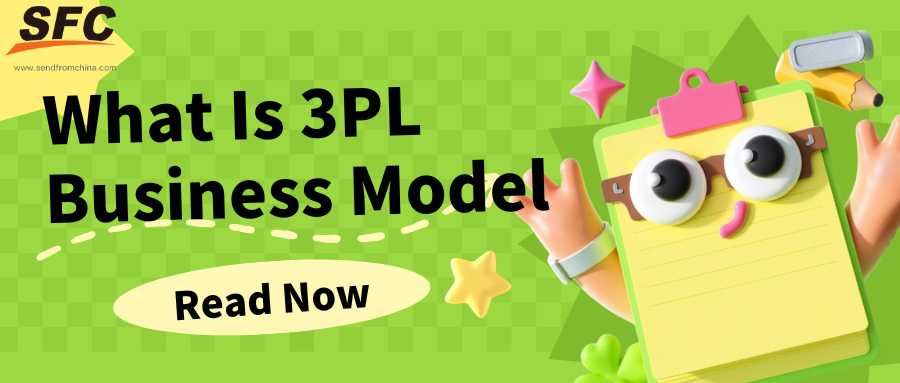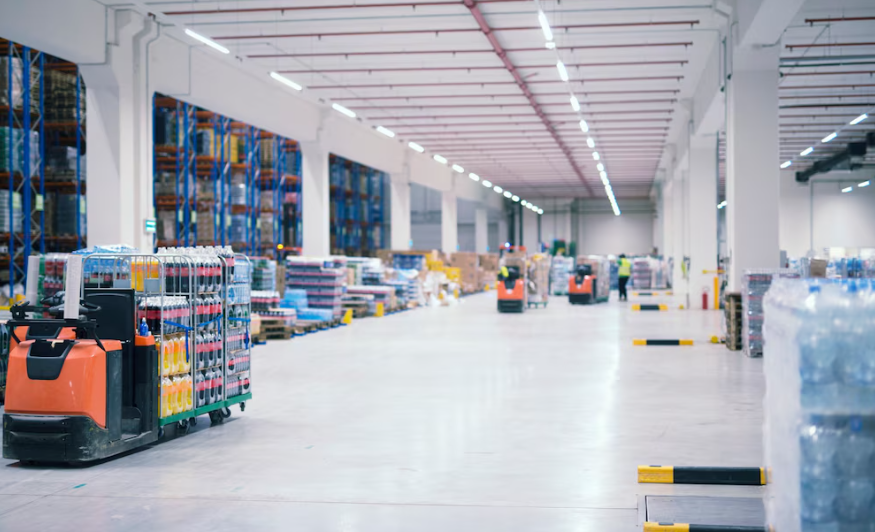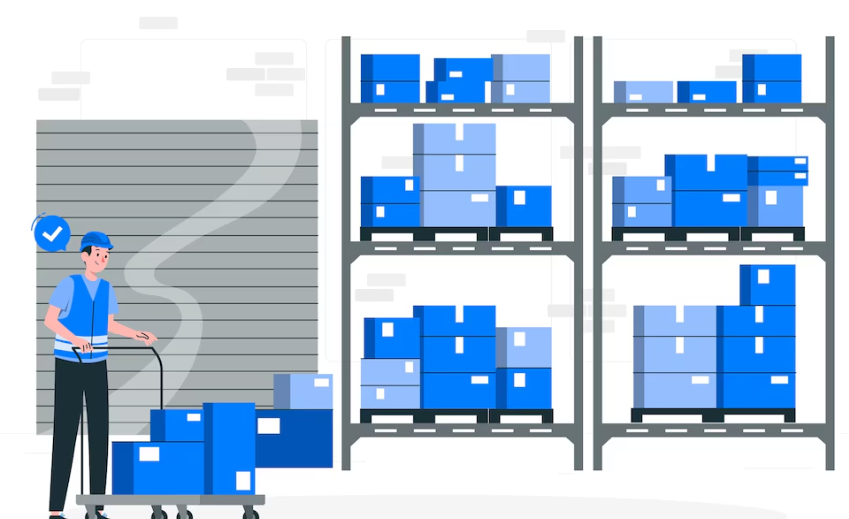Table of Contents
What Is 3PL Business Model? A Complete Guide for Brands & Providers
Time: Jul 28,2025 Author: SFC Source: www.sendfromchina.com
When a brand searches for ways to streamline operations, scale rapidly, and contain logistics costs, one solution surfaces again and again: the 3PL business model. Third‑party logistics has evolved into a vital component of modern supply chain management, where companies outsource warehousing, shipping, fulfillment, even returns handling to expert providers.
Ready for a deep dive? We’ll also walk you through:
- the different tiers and provider types you’ll encounter in the industry
- reasons brands increasingly turn to 3PL for fulfillment and global growth
- how to launch a successful 3PL operation yourself
- core revenue streams that power this business model
- strategic considerations you’ll need as a provider in this competitive space
In short: if you’re exploring what a 3PL business model really means, or you’re planning to build or refine one, this guide gives you the clarity and insight to move confidently.
1. What Is a 3PL Business Model?
A 3PL, or third‑party logistics, is a business model whereby a company outsources logistics and supply chain functions—such as warehousing, transportation, order fulfillment, even value‑added services—to an external provider. Rather than handling all logistics internally (the so‑called 1PL or first‑party logistics model), brands increasingly rely on specialist 3PL partners to manage these operations.In this model, a brand manufactures or procures products and sends them to a 3PL’s facilities. The 3PL logs inventory, receives client ecommerce or retailer orders, picks, packs, ships, and even manages returns—all without taking ownership of the products themselves. Some 3PLs go further, offering customs clearance, labeling, assembly, consulting or order processing services.
Essentially, a 3PL provider acts as an operational extension of a brand, absorbing logistical complexity so the brand can focus on product, marketing, and growth.
2. Different Types and Tiers of 3PL Business Models
Understanding the full spectrum of 3PL structures is essential to match the right type of provider with the right needs—whether you're a brand seeking help or a provider wanting to position yourself strategically.
Logistics Tiers: From 1PL to 5PL
In the broader logistics landscape, providers are often categorized by how deeply they integrate into a brand’s supply chain:- 1PL – The company manages logistics internally (no outsourcing).
- 2PL – A dedicated carrier handles a single logistical function, such as shipment or trucking (e.g., ocean freight carriers or parcel couriers).
- 3PL – This is the core operational outsourcing model: providers handle warehousing, fulfillment, transportation, and even returns for the client.
- 4PL – More strategic orchestration: a 4PL oversees multiple logistics providers (often multiple 3PLs) and optimizes the overall supply chain, without owning physical infrastructure.
- 5PL – Future‑focused and technology-driven, integrating multiple global networks and supply‑chain functions at a systems level—with consultancy, AI, and digital orchestration of fragmented logistics resources.
The Hertz & Alfredsson Classification: Four 3PL Types
According to Hertz & Alfredsson’s widely cited framework (2003), 3PL providers cluster into four categories based on their customer integration level and sophistication:- Standard 3PL: These providers offer foundational services—pick‑and‑pack, basic warehousing, and distribution—generally in a transactional manner. They serve multiple clients with little customization.
- Service Developer: Builds on the standard model by offering value-added services such as cross-docking, specialized packaging, tracking systems, custom labeling, or security protocols. These providers lean on strong IT and economies‑of‑scale to deliver incremental benefits.
- Customer Adapter: Integrates into a client’s logistics operations more deeply—adapting processes and systems to fit the brand’s workflows. While they may not redesign logistics, they execute on behalf of the client and maintain tighter operational alignment.
- Customer Developer: At the highest tier of integration. These providers effectively run a client’s entire logistics function, building fully customized systems and processes—often for a small number of clients—with high operational involvement and strategic coordination.
3. Why Brands Need to Partner with 3PL Businesses
In today’s fast-paced, customer-driven economy, logistics isn't just a back-office task—it’s a pivotal growth lever. Partnering with a third-party logistics (3PL) provider delivers multiple strategic advantages, allowing brands to scale more efficiently, operate more flexibly, and boost customer satisfaction. These elements are increasingly vital for brands navigating complexity, seasonal demand fluctuations, and tighter margins.
Significant Cost Savings & Operational Efficiency
Running logistics in-house often demands major capital investment—warehouses, fleets, software, and staff. A 3PL converts these fixed costs into flexible, usage-based expenses. Brands tap into shared infrastructure—warehouse space, labor, technology—without heavy upfront costs:- Flexible billing avoids long-term leases or full-time teams.
- Companies benefit from economies of scale: bulk purchasing, optimized carrier rates, and efficient labor allocation.
- Overhead and stranded assets are minimized, improving profitability and cash flow.
As a result, many businesses report up to 10% reductions in logistics spending and significantly improved margin visibility.
Accelerated Speed to Market & Geographic Reach
With a distributed network of fulfillment centers, 3PL platforms allow brands to offer faster delivery—often 1–2 days—to major markets—without building new infrastructure. This enables:- Zone-skipping strategies to minimize last-mile cost.
- Rapid regional expansion—crucial for scaling ecommerce, omnichannel and global brands.
- Enhanced logistics flexibility that adapts to market demand shifts, including during seasonal peaks.
Access to Expertise & Advanced Technology
Most brands can’t afford cutting-edge logistics tech in-house. 3PLs bring:- Sophisticated warehouse management systems (WMS), TMS, RF scanning, AI routing, and predictive analytics.
- Access to robotics, cobots, AI-driven picking systems, RFID tagging, and client dashboards—all built into the provider’s platform.
- Industry-specific compliance knowledge—cross-border shipping, bonded warehousing, customs clearance, hazardous goods handling.
Teams benefit from experience honed across multiple clients and verticals, enabling smarter operations and fewer errors.
Enhanced Customer Experience & Retention
Modern customers have rising expectations—fast delivery, consistent tracking visibility, branded packaging, and seamless returns. Partnering with a 3PL helps brands deliver on all these:- Reliable fulfillment accuracy, order tracking updates, and branded packaging elevate perception.
- Efficient reverse logistics (returns, replacements, refurbishments) keep shoppers satisfied and loyal.
- Data shows 91% of brands using 3PLs report improved customer satisfaction and supply chain performance.
Scalability & Flexibility without Risk
Brands with seasonal demand—like fashion, holidays, or promotions—need scalable logistics without permanent infrastructure. A 3PL enables:- Dynamic scaling of space, labor, and services to meet peaks.
- Avoiding under-utilized facilities or staffing during off-peak months.
- Flexibility to test new markets or channels before committing capital.
Improved Resilience & Supply Chain Reliability
Supply chain shocks—from trade disputes to political instability—are increasingly common. A trusted 3PL partner offers:- Network redundancy across multiple warehouse locations and carriers.
- Flexibility to reroute or consolidate orders midstream.
- Strategic tools like bonded warehouses that help brands delay tariffs until sale—providing cash flow flexibility amid trade uncertainty.
In other words, logistics outsourcing enhances adaptability and risk mitigation.
Strategic Focus on Core Competencies
Outsourcing logistics allows brands to concentrate resources on innovation, design, marketing, and growth rather than operational logistics. Many executives say offloading fulfillment enables them to return to what originally excited them about their business—product strategy and customer engagement.Industry Trust & Rising Adoption
- Over 90% of Fortune 500 companies now use 3PL services, among both small and large firms.- 91% of shippers agree 3PL partnerships significantly boost supply chain performance.
- 70% or more of 3PL business comes from e-commerce fulfillment—reflecting rapid digital channel growth.
These stats illustrate how critical 3PL partnerships have become across the modern brand landscape.
4. How to Start a Successful 3PL Business
Launching a third-party logistics (3PL) venture isn’t merely about leasing warehouse space and buying forklifts—it’s a strategic journey. From market validation and regulatory compliance to technology investment and client acquisition, each step must be thoughtfully aligned with your vision. Drawing on industry-leading guides and frameworks, here’s how to start strong—and build your business.
Conduct Market Research & Define Your Niche
Start with deep market insight:- Evaluate demand in your region or vertical—e‑commerce, cold‑chain, cross‑border, retail, or returns logistics. Identify underserved pain points: slow delivery times, lack of returns support, fragmented service.
- Understand competitive dynamics. Research major 3PL players and local providers. Spot where their service gaps or pricing mismatches create entry opportunities.
- Choose a clear niche. Whether that’s fashion ecommerce fulfilment, bonded warehousing for imports, or startup-friendly fulfillment for small brands, niche focus enables differentiation and operational clarity.
Develop a Robust Business Plan
Your business plan is your blueprint and your pitch:- Begin with a compelling executive summary outlining what your 3PL will do, who it serves, and why you're different.
- Define your mission, vision, and unique selling proposition (USP)—e.g. ultra-fast turnaround, tech-driven transparency, vertical specialization.
- Outline service packages: warehousing, pick‑and‑pack rates, shipping tiers, value‑added options like kitting or returns management.
- Include a SWOT analysis and competitor benchmarking.
- Build financial projections, covering startup costs, pricing models, client volume scenarios, and break-even analysis.
Legal Structure, Licensing & Compliance
Ensure legitimacy from day one:- Register your chosen legal entity (LLC, corporation, etc.) and apply for local/state business licenses.
- For transportation operations (especially interstate), secure FMCSA motor carrier authority and DOT number; register with UCR annually.
- Obtain required insurance: cargo liability, general liability, workers' comp. If you handle hazardous or sensitive items, add specialized certification.
- Comply with zoning or facility regulations—especially if operating carriers or heavy equipment.
Secure Funding and Budget Wisely
Starting capital is often substantial—typical ranges run $435,000–$1.2M depending on scale and model. Key cost categories include: real estate, fleet (if asset-based), tech, staffing, permitting, and marketing.- Funding options: personal investment, traditional bank loans, SBA-supported business loans, angel investors, or co-founders.
- Consider bootstrapping lean—leasing warehouse space and equipment; scaling tech and staffing as you gain clients.
Warehouse, Operations & Technology Setup
Build your logistics infrastructure thoughtfully:- Select a warehouse location close to your target markets or transport nodes, balancing rent costs and delivery reach.
- Design warehouse layout for efficiency—racking, batching zones, staging areas. Acquire essential equipment: shelving, forklifts, packing stations.
- Implement a strong warehouse management system (WMS) and transportation management system (TMS). Real-time tracking, inventory forecasting, API connections to client storefronts, and billing modules are critical.
- Recruit and train staff: logistics coordinators, warehouse operatives, drivers, client services. Prioritize safety training and strong customer service skills. Establish SOPs and quality-control protocols early.
Build Partnerships & Carrier Networks
Your network is your leverage:- Negotiate favorable carrier contracts—LTL, FTL, parcel, ocean, or air—depending on your service scope.
- Set up supplier arrangements for packaging materials, labels, and warehouse supplies.
- Partner with local transport brokers, customs brokers, or nearby facilities to fill capacity gaps or support client requirements.
- Cultivate long-term relationships; trust and consistency help with price stability and scalability.
Sales & Marketing Strategy
Kick off your brand presence:- Create a professional website that clarifies services, niches, and benefits. Include client-facing dashboard features or tech previews.
- Develop a sales deck and elevator pitch tailored to your target client type—e‑commerce brands, manufacturers, importers.
- Use content marketing: blog posts, case studies, infographics that educate potential clients on logistics ROI and service differentiation.
- Engage actively on LinkedIn, attend industry conferences, and network in logistics forums. Leverage testimonials and early client wins.
Pilot Clients & Operational Tuning
Start small and learn fast:- Begin with a limited set of pilot clients—perhaps smaller merchants or initial vertical partners.
- Monitor operations closely—track order accuracy, processing time, fulfillment cost per order, inventory shrinkage, and client satisfaction. Adjust workflows as needed.
- Use insights from pilots to refine pricing, SOPs, staffing levels, and tech integrations. Build repeatable onboarding and billing mechanisms.
Measure KPIs & Scale
Track metrics that matter:- Fulfillment accuracy rates, on-time delivery percentage, cost per pick, inventory turnover, client retention rates.
- Maintain Service Level Agreements (SLAs) to enforce standards.
- Once systems stabilize, scale incrementally—adding space, staff, new services or verticals.
- Consider branching into hybrid, asset-light, or niche services to diversify revenue.
5. How Does a 3PL Business Make Money?
A 3PL (third‑party logistics) business typically generates revenue across multiple streams—blending core services, technology-based offerings, and strategic value-adds. Here’s how leading 3PL firms monetize their operations:
Warehousing & Fulfillment-as-a-Service (FaaS)
Perhaps the most foundational revenue driver, warehousing and fulfillment fees form the backbone of 3PL business models. These include:- Storage charges (by pallet, cubic foot, day-end inventory snapshot or hybrid models).
- Pick‑and‑pack fees, charged per order, per unit, or per SKU.
- Inbound/outbound handling, receiving, staging, and shipping operations.
This is widely referred to as Fulfillment-as-a-Service (FaaS)—where inventory holding and order execution become core billing items. Efficient billing models and accurate calculations are key to profitability on the warehouse floor—not just in finance reports.
Transportation & Shipping Services
3PLs often act as both carriers and brokers, deriving margins from shipments they manage:- Offering FTL (full truckload), LTL (less-than-truckload), parcel, air/sea freight, and expedited on-demand or hotshot options.
- In brokerage models, providers negotiate carrier rates, then mark them up—often aiming for 15%+ gross profit margins on spot or ad-hoc services.
These transport margins often beat fixed-rate contracts, particularly for rush or specialty shipments.
Value-Added Services (VAS)
Beyond basics, many 3PLs offer a suite of optional services:- Kitting, tagging, custom packaging, light assembly.
- Returns and reverse logistics, quality checks, restocking.
- Specialized handling (e.g. cold chain, hazardous goods).
These services are billed per unit or per activity, adding margins on top of core fulfillment revenue.
Technology & Analytics Services
As logistics digitalizes, 3PLs increasingly monetize tech:- Charging subscription or access fees for client dashboards, reporting, inventory visibility.
- Offering integration services to sync with ecommerce platforms or ERP systems.
- Delivering predictive analytics, demand forecasting, or consulting for shipping optimization.
This aligns with revenue streams from SaaS-style models, centering on recurring access and usage-based tiers.
Subscription or Minimum Commitment Fees
To stabilize revenue:- Some providers require monthly retainers, minimum order volume commitments, or fixed fees per client.
- This ensures a baseline income—even during off-peak season or low-order volume intervals.
- Often combined with transactional billing for transparency and scalability.
Brokerage or Supply Chain Management Margins
For non-asset-based or “lead logistics” models:- Providers coordinate services with a carrier or partner network.
- Revenue arises from brokerage fees over the cost paid to subcontracted partners.
- Also includes consulting or supply chain orchestration—for example, working as a 4PL-like integrator without owning assets.
Consulting & Industry-Specific Services
Some 3PLs expand into advisory roles:- Inventory and freight optimization consulting.
- Compliance support (e.g. bonded warehousing, customs clearance).
- Vertical specialization (fashion, food, biotech) and tailored logistics frameworks.
This revenue stream is built on expertise rather than volume—commanding higher margins on fewer clients.
Diversification & Emerging Models
Advanced logistics players are finding new avenues:- Sustainability-led logistics: green packaging, carbon-offset shipping, sustainable handling services billed as premium options.
- Vertical alliances or horizontal partnerships—pooling warehouse capacity or tech platforms to sell co-branded services across regions.
These models allow revenue sharing and expansion into markets without new capital expenditures.
6. Strategic Considerations for Setting Up a 3PL Business (for Providers)
If you're a logistics company considering offering a 3PL business model, or a brand thinking of launching one:- Identify Your Niche: Analyze market gaps—maybe in temperature‑controlled warehousing, fast turnaround e‑commerce fulfillment, or bonded warehouse solutions for tariff‑sensitive supply chains.
- Build Scalable Infrastructure: Warehouse locations, technology stack, carrier networks and automation tools are essential. Real-time data, robotics, smart routing systems and inventory intelligence can differentiate your service.
- Offer Tiered Service Levels: Platforms should include basic storage and pick‑pack, mid‑tier value‑adds like kitting and cross‑docking, and full integration models for high‑touch clients.
- Secure Tech Integrations: Robust API, ERP/WMS integration and EDI capability are table stakes. E‑commerce platforms such as Shopify or WooCommerce should plug in seamlessly.
- Focus on Customer Orientation: Flexibility, reliability, customer adaptation and responsiveness often matter more to clients than just cost savings.
7. Conclusion
The 3PL business model is a robust and scalable logistics outsourcing structure—helping brands delegate warehousing, shipping, fulfillment, inventory control, and returns handling to expert providers. Benefits range from cost savings, flexibility, and technological capability to a leaner focus on core brand functions. On the flip side, companies must manage loss of direct control, system integration challenges, and service alignment. With the rise of bonded warehouses, robotics, and integrated digital platforms, 3PL providers are evolving rapidly. Selecting the right partner—one that aligns with your operational needs and strategic goals—can transform your supply chain into a strategic asset instead of just a cost center.8. FAQs
1. What does “3PL” stand for?
It stands for Third‑Party Logistics, meaning outsourcing logistics functions to an external provider.2. What services can a 3PL offer?
Typical services include warehousing, inventory management, order fulfillment, transportation coordination, and returns processing—sometimes extended to kitting, labeling, or cross‑docking.3. How is a 3PL different from a freight forwarder?
A freight forwarder typically handles transportation and customs. A 3PL can manage the full logistics value chain—from storage to final delivery and returns.4. Are there risks in using a 3PL?
Yes: you may lose some operational control, face integration or compatibility issues, and incur complexities in managing returns through an external partner.5. When is a 3PL most useful?
When you need logistics scale without capital investment, want faster delivery, have seasonal peaks, or seek flexibility to enter new markets—especially in e‑commerce contexts. Post Views:1853
Post Views:1853
Copyright statement: The copyright of this article belongs to the original author. Please indicate the source for reprinting.
Previous Post
Ultimate Guide to Warehouse Operations: Processes, Workflows & Resources
Next Post
Prohibited vs. Restricted: A Clear Guide to Shipping Restrictions
TAGS
Hot Research
Get a Custom China Fulfillment Solution with FREE Storage for 30 Days
 Want to know about our services, fees or receive a custom quote?
Want to know about our services, fees or receive a custom quote?
 Please fill out the form on the right and we will get back to you within a business day.
Please fill out the form on the right and we will get back to you within a business day.
 The more information you provide, the better our initial response
will be.
The more information you provide, the better our initial response
will be.





 TAGS:
TAGS: